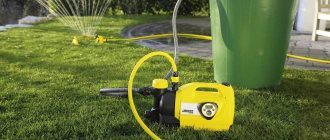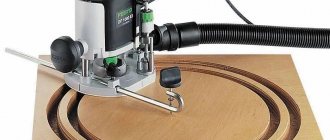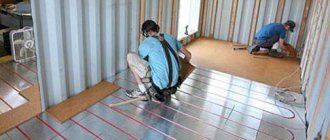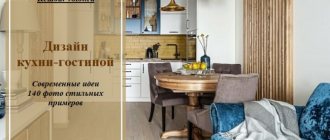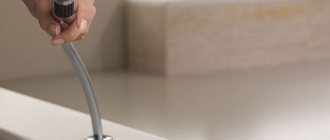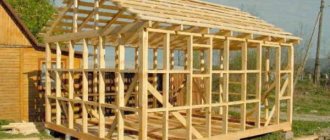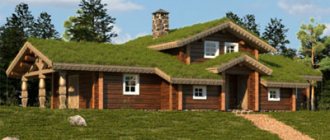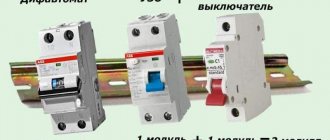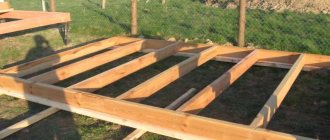@Karkasnii_dom Soundproofing is a labor-intensive and time-consuming process, since you need to select materials, technologies, and carry out the arrangement work itself, which takes a lot of time. But this is the only way to protect your home from extraneous sounds from the outside, as well as create privacy for all rooms, since no noise will spread beyond the walls of the room. In a home environment, you want to rest, relax and gain strength, but it is not always possible to achieve such comfort, since the lack of additional sound insulation disrupts the overall comfort of the space. Therefore, complete sound insulation in a frame house when using special means and methods.
Ceiling soundproofing
To protect the ceiling of a frame house from extraneous sound, it is recommended to use special soundproofing panels that can contain sounds and create a comfortable space. They will be able to create a multi-level ceiling covering, making the interior more sophisticated and practical. They can be purchased ready-made, or you can create them yourself, providing the appropriate technical and practical features.
@Potolok
Manufacturing requires plasterboard, metal profiles for assembling the structure, sound-absorbing products, brackets, and screws. Correct combination ensures convenient, high-quality performance of the assigned work.
The metal profile serves as a means for assembling the frame structure on which all products will be “hung” as part of sound insulation. And between the wall and the frame, a layer of vibration-absorbing product must be laid so that the comfort in the building is not disturbed in the future. Cork, rubber tape, and foam polystyrene are suitable for this purpose. Only after the structure is ready can you begin installing the sound-absorbing product. There are different types of coatings, so they must be installed in accordance with established rules in order to avoid operational discomfort in the future.
Note! After installing the insulation, it is necessary to treat the seams with sealant so that they do not become a place that allows moisture to pass through, disturbing the temperature space.
Fiberglass
The principle of making fiberglass is as follows: recycled glass is melted at high temperatures and pulled into very thin fibers. Due to the fiber length (150 m or more), a high degree of sound absorption is ensured.
It comes in the form of slabs and mats, and is characterized by ease of installation and a minimum number of joints. Fiberglass will be an ideal solution for soundproofing attics, attics, and walls.
Soundproofing walls
Effective sound insulation of a frame house will only be if all walls are carefully treated with soundproofing panels, thanks to which you can count on the practicality and ease of use of the house.
Many are of the opinion that for good sound insulation the use of insulation alone will be enough, but, as practice shows, it will not be possible to achieve the desired effect. Therefore, the inner surface of the walls must be treated with sound-absorbing materials that can guarantee a comfortable space. The standard option is the use of mineral wool and plasterboard, which achieves special efficiency. But the connections must be sealed to protect against vibration waves, as they can disrupt the overall comfort of the room. The number of layers, depending on the desired type of sound insulation, is selected individually.
@Steni
In addition to standard mineral wool, felt and plasterboard can be used to create a multi-level soundproofing structure. But it is best to select effective panels of small thickness to avoid “overloading” the walls.
External decorative design of walls using panels or lining allows not only to create a comfortable sound space, but also to emphasize the thermal insulation in the room.
Important! To equip a frame house, only environmentally friendly materials should be used to avoid hygienic discomfort.
ZIPS
Sandwich panels or ZIPS modules are a modern material for sound insulation; they are a slab with basalt fiber inside and a solid sheet of plasterboard on the outside. Their advantages:
- light weight, which allows them to be attached to the ceiling;
- wide range of applications in any type of premises;
- ease of installation;
- corrosion resistance;
- can be used in damp areas.
The use of ZIP panels makes it possible to reduce energy costs by 30%.
Soundproofing the floor
Floor soundproofing is usually installed in the interfloor space, since this does not take up extra space and ensures appropriate efficiency. The “floating floor” system is created to ensure uniform load distribution, and the structure is not attached to load-bearing elements, which ensures complete soundlessness.
@pol
But the flooring is installed directly on the soundproofing layer, which ensures comfort, warmth and practicality during use. And the wall coverings used to create partitions are separated by vibroacoustic pads, which ensure sound suppression. Do not be afraid of the appearance of the room, since the gasket is hidden under the baseboard, which emphasizes the originality and comfort of the room.
A valid option for a frame house would be the “insulated beams” technique, which involves carefully insulating the ceiling beams separately for the floor beams, so noise is not transmitted or spread throughout the room.
Important! The correctly chosen technique allows you not only to soundproof, but also to insulate the room.
Features of sound conductivity of wooden buildings
The porosity of wood has become the main reason for the good transmission of waves of different frequencies. Residents of a wooden house, which was not protected from noise during construction, feel like they are inside a music box, only it is not music that is heard around them, but any sounds - the sound of footsteps, a conversation, the running of a water tap, etc.
In addition, over time the tree dries out. And this makes the seams between the material more vulnerable and changes the structure of the timber itself. The insulating qualities, which were initially not high, are further reduced. Therefore, soundproofing a wooden house is especially important. There are a number of methods that solve the problem of sound insulation, but each of them should be considered separately, based on the characteristics of construction and the layout of a wooden house.
Any soundproofing work must be done directly during the construction of the house. This approach will significantly reduce the cost of materials and finances, and improve the quality of the operation.
In addition to using special construction sound absorbers, you can resort to some tricks that will reduce the noise conductivity in the room. This is primarily textiles. An abundance of curtains, carpets, upholstered furniture, and pillows dampens the noise in the room. On the contrary, metal objects, ceramics, and stone enhance sound vibrations. But still, the greatest effect is achieved by using soundproofing materials.
Sound insulation of roof, ceilings
Owners of a frame house are faced with difficulties in terms of violating the soundproofing space during rain, as it provokes the appearance of “drum rolls”. Basalt or glass wool can solve the problem, since the soft and dense structure helps prevent the occurrence of sound disturbances.
@Perekritie
You also need to install a layer of insulation between the rafters in order to maximally protect the space from the penetration of extraneous sounds and create additional thermal insulation.
Important! For insulation of rafters, fiberglass tape or impregnated felt is best suited.
Loaded vinyl or sound block
When it comes to insulating a house from sound penetration without taking up a large amount of usable space, loaded vinyl (sound block) is used. This is a modern material that combines the functions of polymer and mineral and exhibits maximum efficiency even with a thickness of 3 mm.
It can be used to soundproof partitions in a wooden house or apartment. Advantages of the film:
- elasticity;
- moisture resistance;
- sound absorption of one layer is 25 dB.
To achieve greater efficiency, you need to use an insulator in two or more layers.
Windows and doors
For better soundproofing effect, sealed double-glazed windows are used, which can guarantee comfort and convenience for residents. For a frame house, two-chamber and three-chamber double-glazed windows are ideal, since single-glazed windows cannot cope with full noise protection.
@Okna
When choosing double-glazed windows, you should take into account the distance between the profiles, and the thickness of the profile and the width of the air chambers should differ, since this ensures reliable and comfortable use without violating technological features.
As practice shows, most often consumers neglect the need for additional soundproofing of doors, although in fact this is an extremely important measure that can provide comfort and coziness. In addition, such sound insulation in a frame house allows you to create an optimal microclimate, thanks to which you can save on heating.
To protect the door frame from noise penetration, it is recommended to follow the following recommendations:
- You can eliminate all the gaps between the box and the partition using sealant.
- Doors must be sheathed with soundproofing materials, namely fiberglass, foam rubber, mineral wool or leather, which additionally adds charm to the structure.
- It would be better to glue a seal around the perimeter of the door, which eliminates the gaps between the door leaf and the frame.
- It would be a good idea to install a soundproofing threshold.
Note! Some manufacturers provide doors already complete with soundproofing materials, so there is no need to further clarify what to do to make the room more comfortable.
How else can you soundproof a frame?
For protection, they resort to non-standard, innovative materials that absorb sound. The following insulators can be used in a frame building:
- Mineral wool acoustic slabs. They have a fibrous structure that repeatedly reflects sound waves, which leads to their attenuation.
- To increase the level of sound absorption by thin partitions, vibration-damping coatings that are highly elastic are used. They contain bitumen, silicone, mineral fillers, polymer and plasticizing additives. Noise muffling can be achieved by installing an insulation layer two to three times thicker than the base.
- Elastomeric vibration damping plates. Widely used in frame construction for sound absorption of floors and ceilings. Completely muffles the noise of engineering equipment and household appliances.
Materials for noise absorption and insulation
The noise elimination procedure will combine technical features only if the material is chosen correctly. Due to the development of production capabilities, each buyer can easily choose what suits their needs.
Cork sound insulators
The material is suitable for sound insulation in terms of keeping out high-frequency noise, which could be dogs barking, screaming, or listening to music loudly. In practice, cork is used as a main or auxiliary material for insulating walls and floors.
Loaded vinyl (or sound block)
This is a dense, expensive membrane that functions not only as a sound insulator, but also as a high-quality insulation material. But the large thickness of the product can create additional difficulties, so the need is initially assessed. But at the same time, the thickness of the material provides high-quality sound protection.
ZIPS
These are structurally rigid materials that have proven themselves in the field of soundproofing frame houses. As a rule, it is used to arrange space in interior partitions, suspended ceilings and other similar structures. It is possible to glue panels under wallpaper, since their small thickness and the ability to create a perfectly even coating are considered the main advantage.
Substrates
This is a thin rolled material made from environmentally friendly and reliable raw materials, so during use it ensures comfort and ease of use. An important property is that the product does not require any effort when gluing, so the soundproofing procedure takes a minimum of time. Additionally, you will be pleased with the reasonable cost, thanks to which there is no need to overpay for popularity and brand recognition.
Fiberglass
It belongs to environmentally friendly materials that are actively used in the field of sound insulation and insulation, therefore ensuring quality, efficiency and convenience. Boards with a middle layer are suitable for insulating partitions and roofs, but in order to avoid deformation due to exposure to moisture, additional treatment with moisture-proofing agents is required. Additionally, a non-woven fabric is used, in which glass wool is wrapped so that it does not crumble during installation, without creating inconvenience.
Foamed polystyrene
This is a popular material, but its level of effectiveness leaves much to be desired. It is presented on the market in the form of slabs or granular material, therefore, depending on the plane of work, the optimal shape can be selected. High thermal insulation qualities are combined with a low level of sound protection.
Mineral wool
Soft and semi-hard options are available. The base uses stone wool, fiberglass and slag melts, so high quality is guaranteed, along with efficiency. The material is suitable for arranging floors and roofs, as it additionally provides good protection against moisture.
Nuances of the process for improving sound insulation
Before selecting and purchasing materials with soundproofing properties, it is necessary to examine the walls for problem areas. Especially, pay attention to cracks and gaps at the junction of communications. Then, it is advisable to carefully close all holes near the sockets. The best option for this would be fiberglass. Also, the level of sound vibrations can increase:
- If the building materials of a wooden building have a low level of sound insulation.
- Poor quality fittings are used, there are gaps in the window and door frames.
- If you choose the wrong finish, which has weak absorption of sound vibrations.
Principles of distribution
To improve the final result, in addition to finishing the walls with sound-absorbing agents, you need to additionally carry out a number of actions:
- Be sure to replace the old door with an updated one, with sealing pads around the perimeter.
- It is advisable to replace wooden windows with PVC structures or double-glazed windows.
- Attach sealing gaskets to the interior passages.
- In private homes, it is advisable to carry out work on finishing the exterior with a sound-absorbing coating.
- In order to reduce the transmission of structural noise, it is advisable to finish the façade with materials that have reflective properties.
After completing the preliminary work, the level of vibrations inside the room will significantly decrease. Also, most of these materials retain heat well in the room.
Drywall
Drywall is often used to insulate walls from noise and cold, but this material itself is useless. For effectiveness, it is recommended to combine it with some kind of filler, for example, mineral wool. A modern development is plasterboard acoustic sheets in which there are a large number of holes, and a non-woven fabric is glued to the surface. Thanks to these details, maximum damping of sound waves occurs.
It is worth considering that the use of drywall “steals” square meters of the room.
Linoleum is a suitable finishing coating
Linoleum manufacturers are not going to give up and are fighting for the market. Linoleum today and 10 years ago are different materials.
Advantages of linoleum:
- He forgives bumps
- Does not react to water
- It’s easier to make transitions invisible without thresholds and drops. PVC tiles or laminate - you can make good transitions, but I haven’t seen it in real life. There are shabby, clinging thresholds.
- There is no clicking sound like laminate.
- It is warmer than laminate.
- Linoleum on a thick backing adds sound insulation
Foamed polystyrene
Expanded polystyrene is an environmentally friendly, heat-resistant, safe, soundproof material. Its quality characteristics have been known for a long time and are in great demand.
When using penoplex and expanded polystyrene to insulate wooden houses, a number of positive aspects can be highlighted:
- ease and ease of processing;
- possibility of use without additional precautions;
- non-susceptibility to deformation.
However, it should be remembered that polystyrene foam is afraid of exposure to chemicals.
